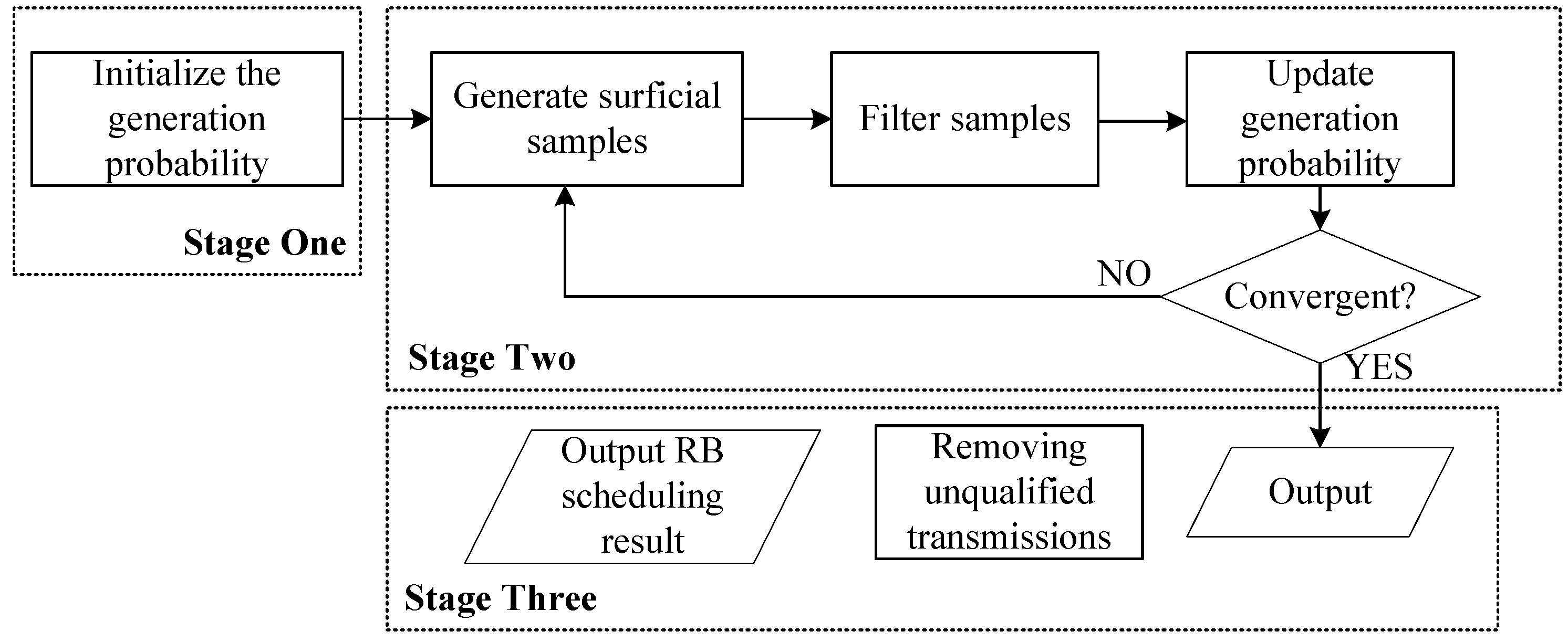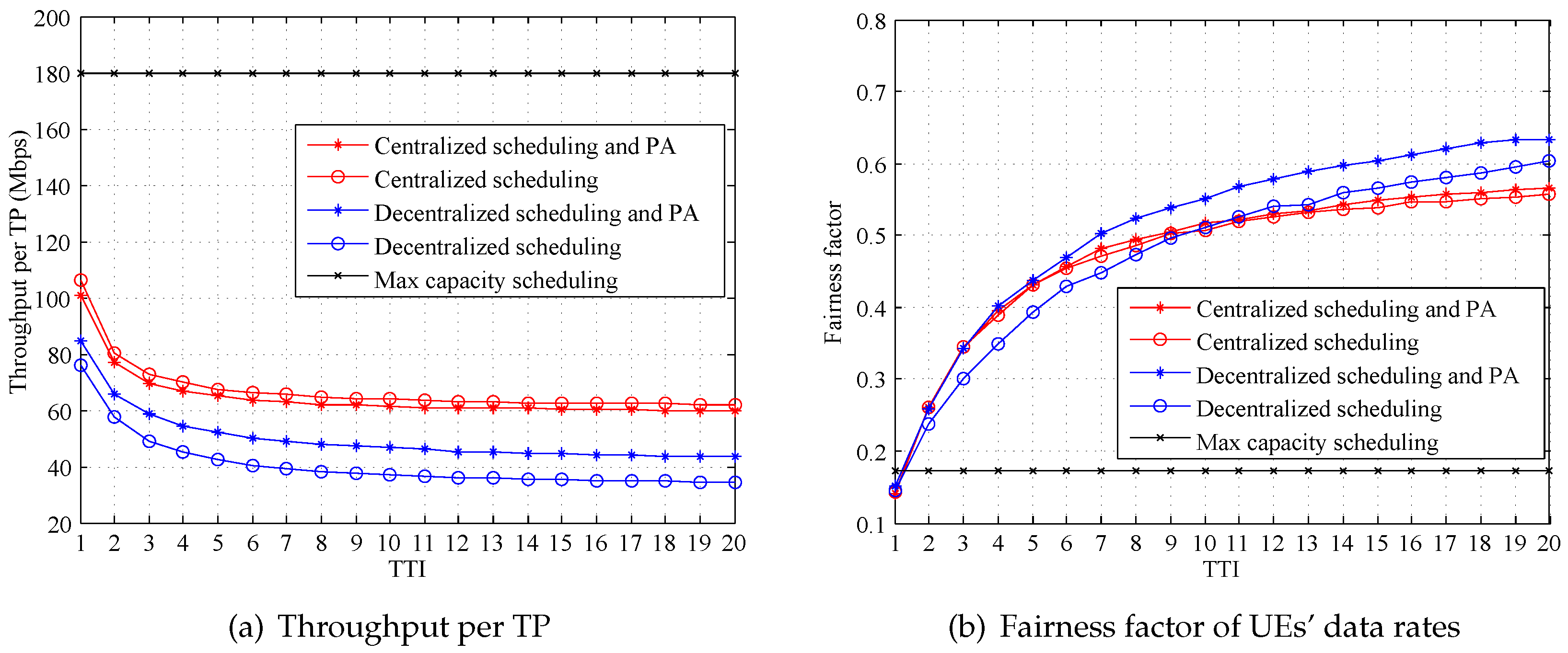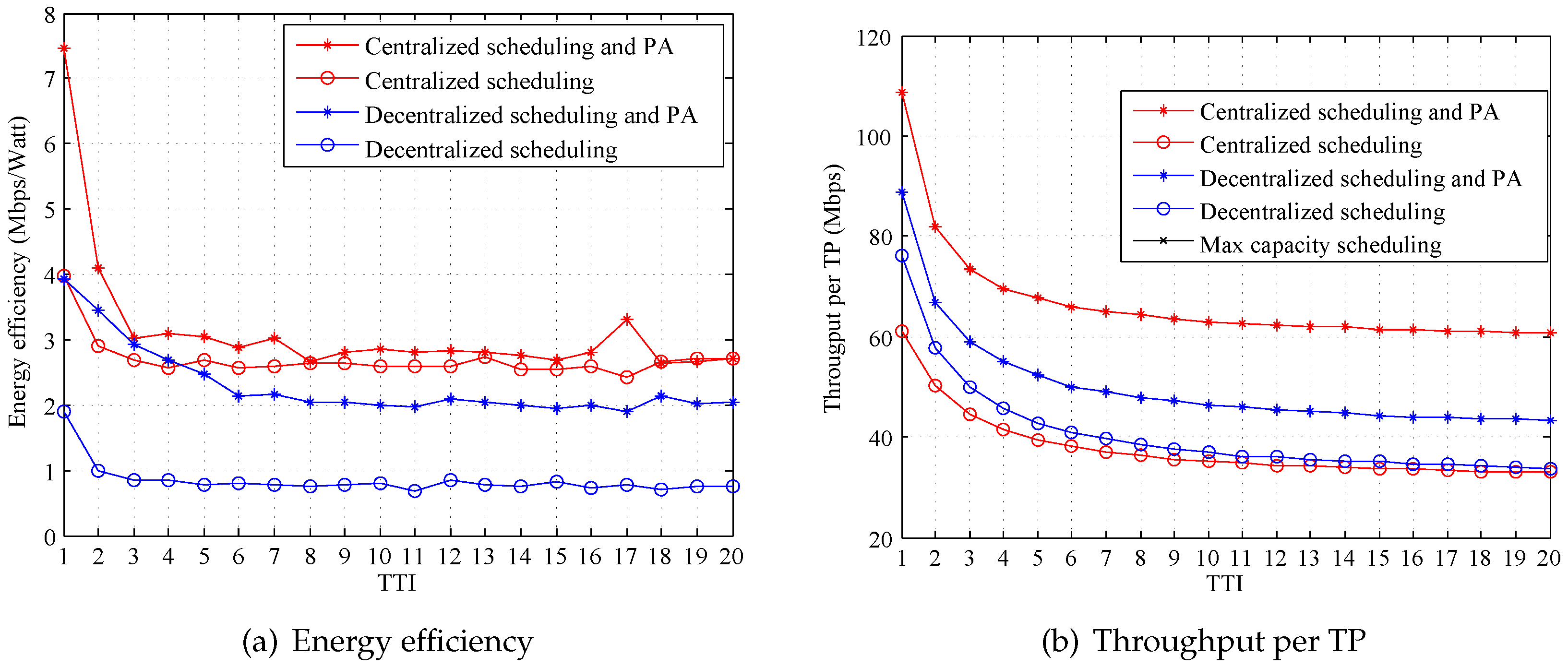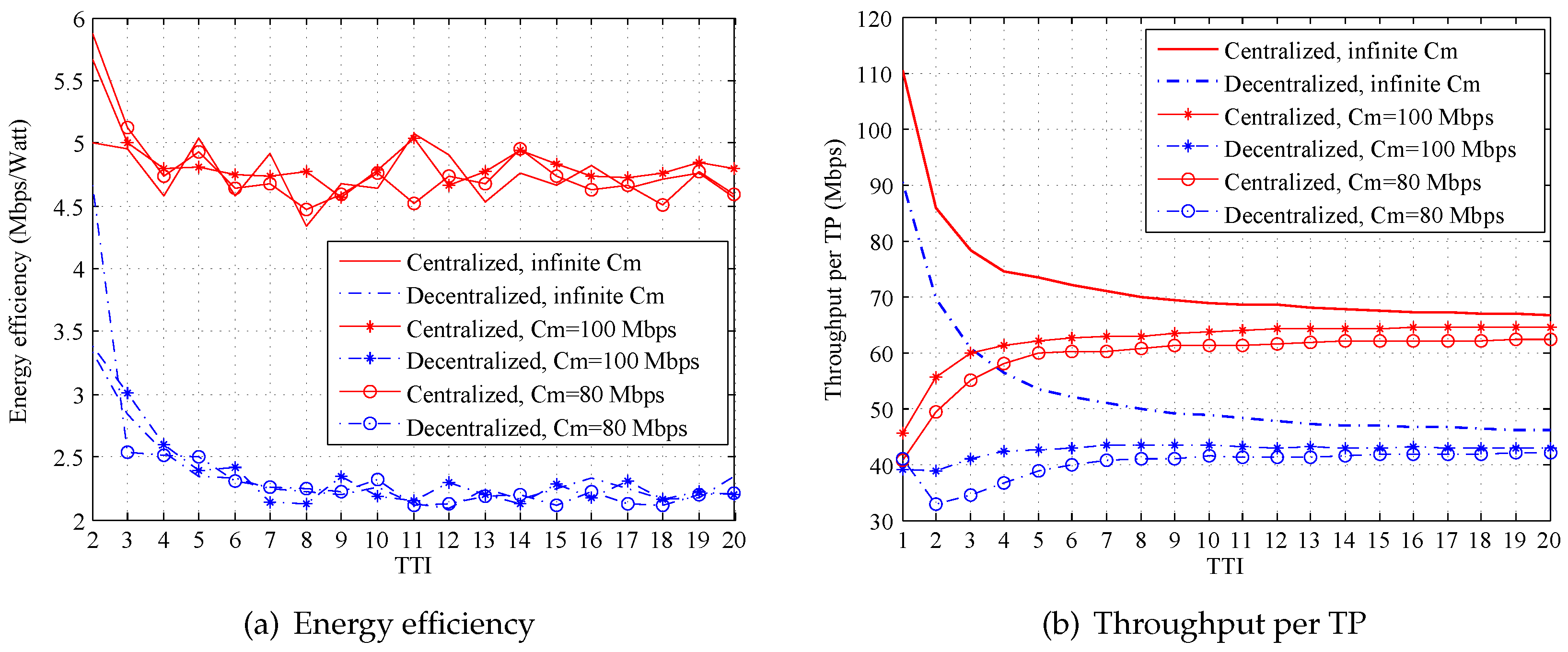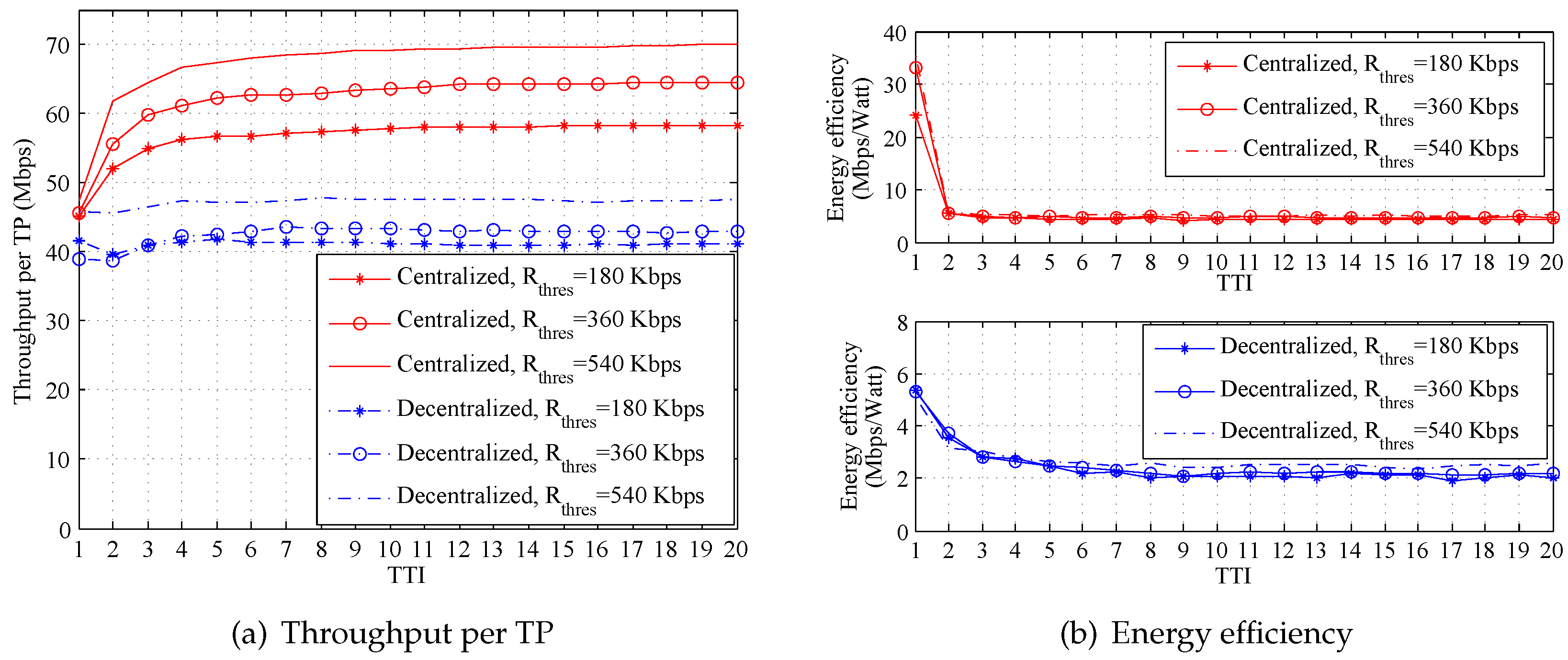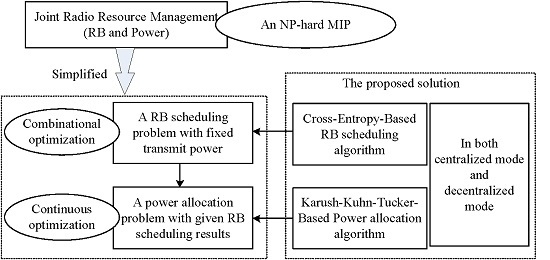1. Introduction
Heterogeneous networks (HetNets) [
1,
2] are proposed in long-term evolution-advanced (LTE-A) systems by the 3rd Generation Partnership Project (3GPP) to not only meet the rapidly increasing demands of mobile data traffic, but also to reduce the huge energy consumptions caused by data transmissions. A HetNet is a hierarchical network where low-power access points (APs, also named small cell sites [
3,
4]) are included in a macro-cell, in order to provide highly qualified services. Typical small cell sites include pico, femto, relay and so forth. Femto [
5] is mainly for indoor transmissions, while pico [
6] is used outdoors in a crowded place, such as a university. Relay [
7] is usually built in a remote area far from the macro-cell site (named the Evolved Node B, or eNodeB, in LTE-A HetNet) to extend the coverage of the macro-cell.
Figure 1 presents a simple example of a HetNet.
Figure 1.
Illustration of a HetNet.
Although HetNets are widely considered as the main trend in the development of mobile communication systems [
3], several challenges should be dealt with before implementation in the real world. One of the major challenges is severe intercell interference aggravated by the dense deployment, which crucially affects the performance of HetNets. As a promising measurement to deal with intercell interference, coordinated multiple point (CoMP) [
8] techniques are considered to be helpful for HetNets. The basic idea of CoMP techniques is to coordinate coordinated neighboring cells, so that intercell interference can be reduced to a large extent. According to the different ways to cooperate, CoMP techniques are classified into two categories, coordinated scheduling/coordinated beamforming (CS/CB) and joint processing (JP) [
9]. CS/CB CoMP makes neighboring cells jointly pre-code according to global channel state information (CSI) to avoid potential interference, while JP CoMP allows neighboring cells to jointly process signals intended for a specific user in the overlapping area. Joint transmission (JT) is a typical JP CoMP technique that requests of cooperating cells to transmit the same data packets to a user independently and simultaneously. In this paper, we take JT CoMP as an example to discuss the performance of CoMP-based HetNet, and the study can also be extended to other CoMP techniques.
To fulfill the requirements of the future mobile networks, CoMP-based HetNets need to provide qualified services as much as possible while maintaining acceptable energy consumption. According to report [
10], energy consumption caused by information and communications technology (ICT) has contributed up to 5% of the world-wild power supply at present. To avoid the further increase of energy consumption, mobile networks are required to significantly improve the utility efficiency of power resources. Radio resource management (RRM), which adaptively allocates radio resources, such as frequency and power, according to CSIs, is beneficial for CoMP-based HetNets to enhance the energy efficiency.
In this paper, we focus on RRM in a CoMP-based HetNet for the purpose of improving the energy efficiency while guaranteeing high data rates, as well as user fairness. An optimization problem aiming at maximizing weighted energy efficiency is formulated, where the weights are employed for maintaining the fairness of users’s data rates. Several crucial constraints in practice are taken into consideration in the formulated problem. Besides the limitation on total power at each transmitter, backhaul links, which connect small cells to the eNodeB for exchanging data and control information, are considered to have restricted capacity. Additionally, the lowest data rate of each transmission is defined, in order to guarantee the quality of transmissions and avoid wasting of energy. Since the formulated problem is unsolvable mixed integer programming (MIP), we separate the whole problem into a scheduling subproblem under the assumption of equal power allocation and a power allocation subproblem with known scheduling results. We first proposed a centralized scheduling algorithm based on cross-entropy (CE) and a corresponding power allocation algorithm. Since centralized algorithms involve numerous calculations, the time delay could be intolerable in a large-scale network. An alternative method to decrease the time delay is to conduct resource allocation in a decentralized way, where calculations are distributed to small cells. For this reason, we also propose modified algorithms that can be used in a decentralized mode.
The rest of this paper is organized as follows. In
Section 2, we present the considered system model. Then, the mathematical formulation of the discussed problem is described in
Section 3.
Section 4 proposes a centralized strategy of resource allocation, which includes a CE-based scheduling algorithm and a power allocation algorithm.
Section 5 modifies the proposed algorithms, so that they can be utilized in a decentralized system. Simulation results and relevant analysis are shown in
Section 6. At last, we conclude our work in
Section 7.
6. Simulation Results
We consider a HetNet downlink system with 37 TPs, where only 19 TPs of these conduct actual communications to UEs, and the others wrap them around to produce virtual interference. The radius of each small cell is 250 m, since a dense deployment is considered. The system includes 100 RBs, each of which is under a bandwidth of 180 kHz. Therefore, the overall bandwidth of the system is 18 MHz. Additionally,
MIMO links are created using the space channel model (SCM) [
17]. Each simulation lasts 20 TTIs, where a TTI is 1 ms. Important parameters used in the simulation are listed in
Table 2.
Table 2.
Parameters in the simulation.
| Parameters | Value |
|---|
| Layout of cells | 37 hexagon cells; wrap-around used |
| Radius of cells | 250 m |
| Central frequency | 2 GHz |
| , number of RBs | 100 |
| , limit of transmit power | 20 Watt |
| 2 × 2 |
| number of TTI / TTI | 20 /1 ms |
| α | 0.1 |
| Channel model | SCM (path loss + shadowing + MIMO fading) |
| Minimal distance (TP and UE) | 35 m |
| Height of transmit/receive antenna | 35 m/1.5 m |
| Penetration loss | 20 dB |
| Traffic model | full buffer |
| Speed of UE | 10 m/s |
The simulation is carried out to prove the proposed algorithms effectiveness. A greedy algorithm, named max capacity, is also simulated as a benchmark. The max capacity algorithm tends to allocate resources to UEs with good channel conditions, in order to reach the optimal throughput of the network. In this way, UEs with worse channel conditions may no chance to communicate. Therefore, the fairness of the max capacity algorithm is unfavorable.
Figure 4 and
Figure 5 compare the performances of the max capacity algorithm to that of the proposed one.
Figure 4 demonstrates the average throughput per TP and fairness factor (as defined by Equation (5)) of the system under different resource allocation algorithms, when the transmit power of each TP is 20 Watts. It is obvious that max capacity algorithm achieves an outstanding throughput and a much worse fairness factor than the proposed one. The future mobile communication system targets to provide not only high throughput of the network, but also quality service to every UE. Therefore, the max capacity is no longer appropriate. The proposed algorithms have much better fairness factors. More importantly, as shown in
Figure 5, the proposed centralized algorithm can also achieve an energy efficiency as good as that of max capacity.
Figure 4.
System performances under different resource allocation algorithms (20 Watts, infinite , kbps).
Figure 5.
Energy efficiencies under different resource allocation algorithms (20 Watts, infinite , kbps).
Results in
Figure 4 and
Figure 5 also compare the performance of the centralized algorithm proposed in
Section 4 and that of the decentralized algorithm in
Section 5. The results show that both energy efficiency and throughput are decreased when the decentralized algorithm is used.
Figure 6 shows the system performances of the proposed algorithms when the transmit power of each TP is 40 Watts. Comparing the results to
Figure 4 and
Figure 5, it can be seen that the energy efficiency of the centralized algorithm significantly decreases when the transmit power of each TP is up to 40 Watts, while the throughput does not increase. This proves that high-level transmit power is not appropriate in a dense network. Additionally, the results demonstrate that the decentralized algorithm is more robust, since both energy efficiency and throughput are changed a little when different transmit powers are used.
Figure 6.
System performance under different strategies (40 Watts, infinite , kbps).
Simulations are also conducted under infinite, 100-Mbps and 80-Mbps backhaul limits, respectively, with a fixed
of 360 kbps, to clearly illustrate the effect on system performance caused by backhaul constraints. Restricted backhaul capacity leads to a low throughput per TP, as shown in
Figure 7a, since fewer transmissions are scheduled in this case. However, the tendency is different in terms of energy efficiency.
Figure 7b shows that the energy efficiencies of the proposed algorithms under different backhaul limits are almost the same. This is explained by the fact that the power consumed by transmissions is also reduced when backhaul capacity is restricted.
Figure 7.
System performance under different backhaul capacity (20 Watts, kbps).
At last, we conduct simulations when
is 180 kbps, 360 kbps and 540 kbps, respectively, with the fixed backhaul capacity of 100 Mbps. This shows that the throughput of our proposals grows as the increase in
, as shown in
Figure 8a. This is because more resources are assigned to the UEs with better channel conditions, which are possible to achieve for quality transmissions.
Figure 8b illustrates that the value of
hardly affects the energy efficiency of the system. Since those transmissions estimated to be inferior to the given
are closed, no (or little) power is wasted. Therefore, that energy efficiency of the system can be maintained at a high level.
Figure 8.
System performance under different (20 Watts, ).
Acknowledgments
We acknowledge Yonsuke Kinouchi, Takahiro Emote and Ye Wang for useful comments for this work and the modification of this paper.
Author Contributions
Jia Yu was responsible for the conception of the paper and the main writing. Shinsuke Konaka, Masatake Akutagawa and Qinyu Zhang were all responsible for the concept of the paper, supervising the work and reviewing.
Conflicts of Interest
The authors declare no conflict of interest.
References
- Damnjanovic, A.; Montojo, J.; Wei, Y.; Ji, T.; Lou, T.; Vajapeyam, M.; Yoo, T.; Song, O.; Malladi, D. A survey on 3GPP heterogeneous networks. Wirel. Commun. 2011, 3, 10–21. [Google Scholar] [CrossRef]
- Zhang, N.; Cheng, N.; Gamage, A.; Zheng, K.; Mark, J.W.; Shen, X. Cloud Assisted HetNets Toward 5G Wireless Networks. IEEE Commun. 2015, 53, 59–65. [Google Scholar] [CrossRef]
- Bottai, C.; Cicconetti, C.; Morelli, A.; Resellini, M.; Vitale, C. Energy-efficient user association in extremely dense small cell networks. In Proceedings of the 2014 European Conference on Networks and Communications (EuCNC), Bologna, Italy, 23–26 June 2014; pp. 1–5.
- Hoydis, J.; Kobayashi, M.; Debbah, M. Green Small-Cell Networks. Veh. Technol. Mag. 2011, 1, 37–43. [Google Scholar] [CrossRef]
- Rangan, S. Femto-macro cellular interference control with subband scheduling and interference cancelation. In Proceedings of the 2010 IEEE GLOBECOM Workshops (GC Wkshps), Miami, FL, USA, 6–10 December 2010; pp. 695–700.
- Wang, Y.; Pedersen, K.-I. Performance analysis of enhanced inter-cell interference coordination in LTE-Advanced heterogeneous networks. In Proceedings of the 2012 IEEE 75th Vehicular Technology Conference (VTC Spring), Yokohama, Japan, 6–9 May 2012; pp. 1–5.
- Peng, M.; Liu, Y.; Wei, D.; Wang, W.; Chen, H. Hierarchical cooperative relay based heterogeneous networks. Wirel. Commun. 2011, 3, 48–56. [Google Scholar] [CrossRef]
- Irmer, R.; Droste, H.; Marsch, P.; Grieger, M.; Fettweis, G.; Brueck, S.; Mayer, H.-P.; Thiele, L.; Jungnickel, V. Coordinated multipoint: Concepts, performance, and field trial results. IEEE Commun. Mag. 2011, 2, 102–111. [Google Scholar] [CrossRef]
- LG Electronics. CoMP configurations and UE/eNB behaviors in LTE-Advanced; R1-090213. In Proceedings of the 3GPP TSG RAN WG1 Meeting, Ljubljana, Slovenia, 12–17 January 2009.
- Tombaz, S.; Vastberg, A.; Zander, J. Energy-and-cost-efficient ultra-high-capacity wireless access. Wirel. Commun. 2011, 5, 18–24. [Google Scholar] [CrossRef]
- Maattanen, H.; Hamalainen, K.; Venalaiene, J.; Schober, K.; Enescu, M.; Valkama, M. System-level performance of LTE-Advanced with joint transmission and dynamic point selection schemes. EURSIP J. Adv. Signal Process. 2012, 247, 1–18. [Google Scholar]
- Introduction to Downlink Physical Layer Design. In LTE, The UMTS Long Term Evolution—from Theory to Practice, 2nd ed.; Sesia, S.; Toufik, I.; Baker, M. (Eds.) Wiley: West Sussex, United Kingdom, 2009; pp. 135–137.
- Yu, W.; Kwon, T.; Shin, C. Multicell coordination via joint scheduling, beamforming and power spectrum adaptation. IEEE Trans. Wirel. Commun. 2013, 7, 1–14. [Google Scholar] [CrossRef]
- Shen, Z.; Andrews, J.-G.; Evans, B.-L. Adaptive resource allocation in multiuser ofdm systems with proportional rate constraints. IEEE Trans. Wirel. Commun. 2005, 6, 2726–2737. [Google Scholar] [CrossRef]
- Rubinstein, R.-Y. Optimization of computer simulation models with rare events. Eur. J. Oper. Res. 1997, 1, 89–112. [Google Scholar] [CrossRef]
- Palomar, D.; Chiang, M. A tutorial on decomposition methods for network utility maximization. IEEE J. Select. Areas Commun. 2006, 8, 1439–1451. [Google Scholar] [CrossRef]
- Salo, J.; Galdo, G.-D.; Salmi, J.; Kyosti, P.; Milojevic, M.; Laselva, D.; Schneider, C. MATLAB implementation of the 3GPP spatial channel model. Available online: http://read.pudn.com/downloads86/sourcecode/app/331591/scm_11-01-2005.pdf (accessed on 28 January 2016).
- Shannon, C.E. A mathematical theory of communication. Bell Syst. Tech. J. 1948, 27, 379–423. [Google Scholar] [CrossRef]
© 2016 by the authors; licensee MDPI, Basel, Switzerland. This article is an open access article distributed under the terms and conditions of the Creative Commons by Attribution (CC-BY) license (http://creativecommons.org/licenses/by/4.0/).


